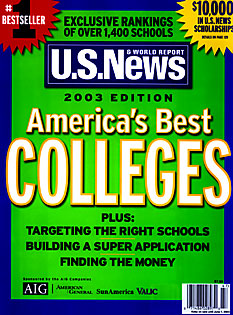 |
|
Top 5 Doctoral Schools:
1. University of California-Berkely
2. University of Virginia
3. (tie) University of California-L.A.
4 University of Michigan-Ann Arbor
5. U. of North Carolina-Chapel Hill
|
|
By Keren G. Raz
Arizona Daily Wildcat
September 20, 2002
U.S. News and World Report drops UA by 11 slots from last year
The UA barely made it into U.S. News and World Report's top 50 public doctoral universities this year, dropping 11 spots from last year's number 39.
The university has been named one of the top public doctoral institutions in the nation for the past three years. Its rank had increased from 48 in 1999 to 44 in 2000 to 39 in 2001, before it dropped down to the bottom of the list this year.
"I'm surprised," said Rick Kroc, director of assessment and enrollment research. "We're as good of a school as last year. I don't see any reason why we should have slipped," he said.
Randy Richardson, vice president for undergraduate education, was not as startled to hear about UA's performance in the rankings.
"In general, I try not to pay much attention to rankings," he said. "There are many different rankings that cater to different people. I think what's important is for the university is to provide a quality education."
The U.S. News analysis reported that 30 percent of classes had twenty students or fewer enrolled in 2001. This is down from 37 percent in 1999.
Compared to other peer institutions that ranked higher, UA had a significantly lower freshmen retention and graduation rate in 2001.
UA had a 77 percent freshmen retention rate and 52 percent graduation rate, while the University of California at Berkeley, which ranked the number one public school in the nation, had a 90 percent freshmen retention rate and a 70 percent graduation rate.
Arizona State University was not ranked as one of the top 50 public doctoral universities.
John L. Wilson, director of decision and planning support, submitted the numbers that US News and World Report used to compile the rankings.
US News and World Report, stated that the analysis "relies on quantitative measures that education experts have proposed as reliable indicators of academic quality, and it is based on our nonpartisan view of what matters in education."
These quantitative measures include a peer assessment by administrators at other universities, graduation and retention rates, faculty resources, student selectivity, financial resources, alumni giving and graduation rate performance.
The variables and weights assigned to each variable have not changed since last year.
US News and World Report would not make all of the specific numbers used to rank each university available.
Wilson expects that budget cuts played a role in UA's drop to the bottom of the list.
"I'm not surprised. When you have fewer faculties and more students, some of the measures are going to go the wrong direction. We're almost certain to be down on faculty resources as compared to our peer institutions," Wilson said.
US News and World Report began to rank colleges in 1989.
Since then it has become a resource for students and families, said Richard Folkers, spokesman for US News and World Report.
"We don't do this as a scorecard or a horse race·we just report the results to help students decide among colleges," Folkers said.
Wilson encourages students and families that look at US News and World Report's list of the top public schools to "take (the rankings) with a grain of salt."
"These are numbers that go up and down randomly. If there is a steady downtrend, then we should be concerned. However, a one-year blip means nothing. The quality of education won't change in one year," he said.

